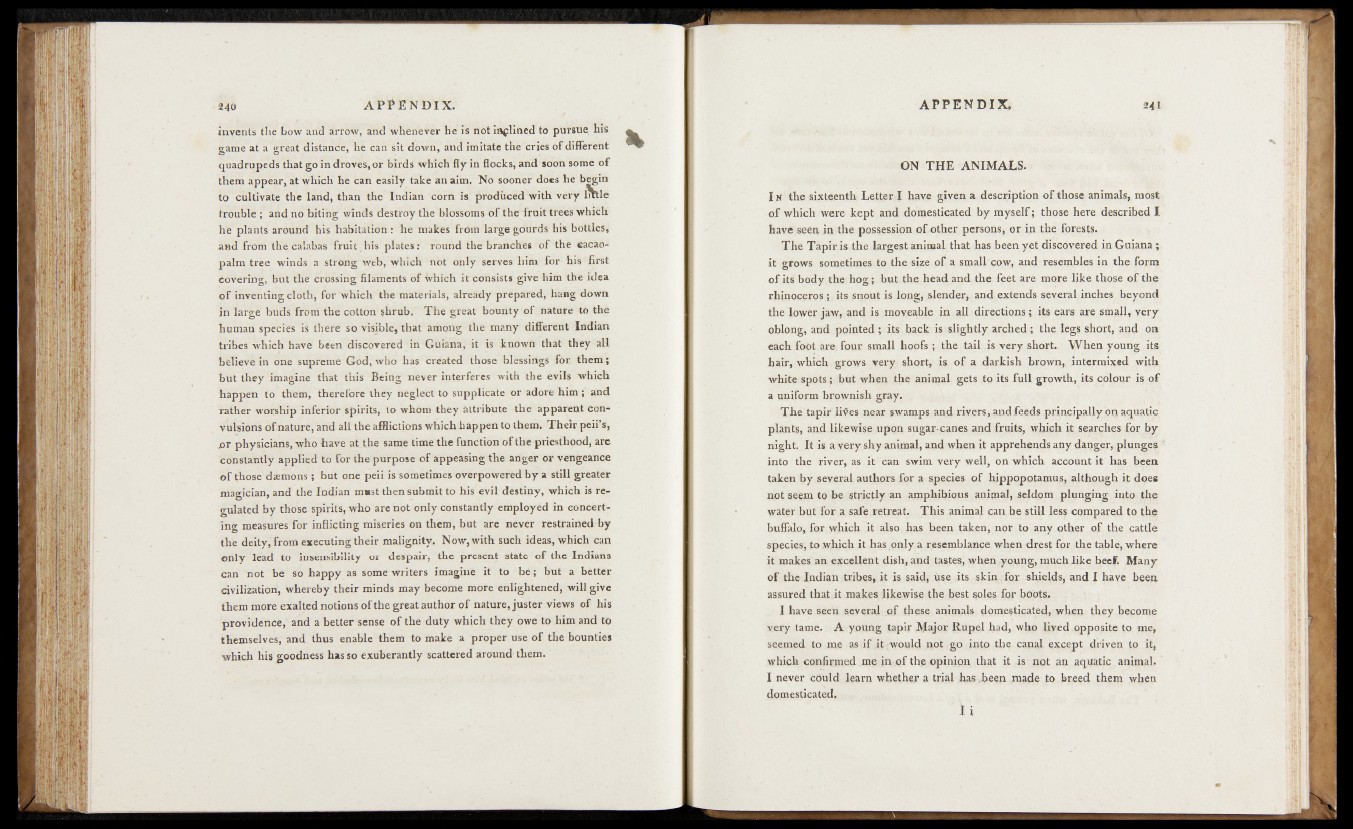
invents tlie bow arid arrow, arid whenever he is not inclined to pursue, his
game at a^great distance, he can sit down, and imitate the cries o f different
quadrupeds that go in droves, or birds which fly in flocks, and soon some of
them appear, at which he can easily take an aim, No sooner does he begin
to cultivate the land, than the Indian corn is produced with very little
trouble ; and rid biting winds destroy the blossoms of the' fruit trees which
he plants around his habitation : he makes from large gourds his bottles;
and frrim the catabas fruit „his plates: round the branches of the cacao-
palm tree winds a strong web, which not only serves him, for his first
covering, but the crossing filaments of •fvhich it consists give him the idea
o f inventing cloth; for which the materials, already prepared, hang down
in large1 buds from the cotton shrub. The great bounty of nature' to the
human species is there' so visible, that among the many different Indian
tribes which have been discovered 'in Guiana, it is known that they all
believe in brie supreme God, who has created those blessings fOr them;
but they imagine that this Being1 never interferes with the evils which
happen to them, therefore they neglect to supplicate or adore him ; and
rather worship inferior'spirits, to whom they attribute -the apparent-convulsions
o f nature, and all the afflictions which happen to them. Thelrpeii's,
or physicians, who have at the same time the function of the priesthood; are
constantly applied to for the purpose of appeasing the anger or vengeance
o f those dieriions ; but one peii is sometimes overpowered by a'still greater
magician, and the Indian must then submit to his evil destiny, which is regulated
by those spirits, who are not only constantly employed in concerting
measures for inflicting miseries on them, but are never restrained; by
the deity, from executing their malignity. Now, with such ideas, which can
only lead to insensibility or despair, the present state of the Indians
can not be so happy as some writers imagine it to be; but a better
civilization, whereby their minds may become more enlightened, will give
them more exalted notions o f the great author of nature, juster views of his
providerice,1 and a better sense of the duty which they owe to him and to
themselves, and thus enable them to make a proper use of the bounties
which his goodness has so exuberantly scattered around them.
ON THE ANIMALS.
I n the sixteenth Letter I have given a description o f those animals, most
o f which were kept and domesticated by myself; those here described I
have’ seén iq th e possession ©Cother persons, or ip the forests.
The Tapir is the largest animal that has been yet discovered in Guiana
it grows sometimes to the si?e of a. small cow, and resembles in the form
of its' body the h o g ; but the head and the. feet are more like those o f the
rhinoceros ;, its snout is long, slender, and extends several inches beyond
the lower jaw, and is moveable in all directions; its ears are small, very
oblong, and pointed ; its hack is fslightly arched; the legs short, and on
each foot are. four small hoofs ; the tail .is- very short.. When young its
hair, which grows very short, is,, o f a darkish brown, intermixed with
white spots; but when the animal gets .to its full growth, its colour is o f
a uniform brownish gray. .
1 Thé tapir lives near swamps and rivers, and feeds principally on aquatic
plants, and likewise upon sugar-canes and fruits, which Sfgrches for by
night. It is a very shy animal, and when it apprehends any danger, plunges
into the river, as it can swim very well, bn which account it has been
taken by seyeral authors for a species of hippopotamus, although it does
npt seem to be strictly an amphibious animal, seldom plunging into the
water but for a safe,retreat. This animal can be still less compared to the
buffalo, for which it also has been taken, nor to any other of the cattle
species, to which it has .only a resemblance when drest for the table, where
it makes an excellent dish, and tastes, when young, much like beef. Many
of the Indian tribes, it is said, use its skin for shields, and I have been
assured thatit makes likewise the best soles for boots.
I have seen several of these animals domesticated, when they become
very tame. A young tapir Major Rupel had, who lived ,qppo,site to me,
seemed to me as if it .-would npt- go into the canal except dri ven to it,
which confirmed me jn-of the opinion, that it. is not an aquatic animal.
I never cöuld learn whether a trial has been made to breed them when
domesticated,
I i